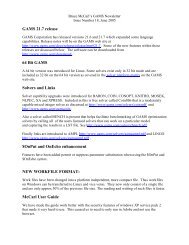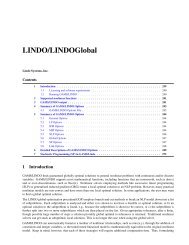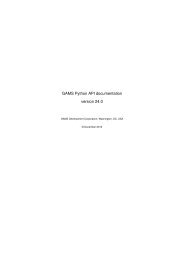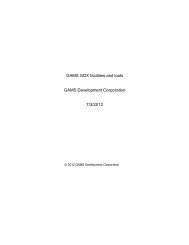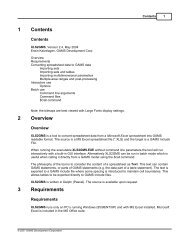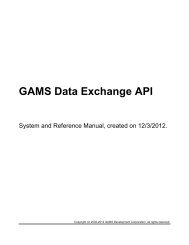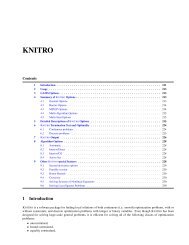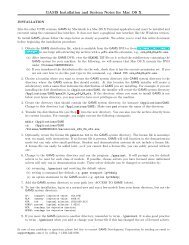Economic Equilibrium Modeling with GAMS
Economic Equilibrium Modeling with GAMS
Economic Equilibrium Modeling with GAMS
You also want an ePaper? Increase the reach of your titles
YUMPU automatically turns print PDFs into web optimized ePapers that Google loves.
48<br />
1. INTRODUCTION<br />
This paper introduces a programming language for economic equilibrium modelling.<br />
The paper presents the motivation for the system, the programming syntax, and three<br />
small scale examples. A library of larger models are provided <strong>with</strong> the program. The<br />
purpose of the paper is to provide a concise introduction to the modelling environment.<br />
MPSGE is a language for concise representation of Arrow-Debreu economic equilibrium<br />
models (Rutherford, 1987). The name stands for \mathematical programming system for<br />
general equilibrium". MPSGE provides a short-hand representation for the complicated<br />
systems of nonlinear inequalities which underly general equilibrium models. The MPSGE<br />
framework is based on nested constant elasticity of substitution utility functions and<br />
production functions. The data requirements for a model include share and elasticity<br />
parameters, endowments, and tax rates for all the consumers and production sectors<br />
included in the model. These may ormay not be calibrated from a consistent benchmark<br />
equilibrium dataset.<br />
<strong>GAMS</strong>, the \Generalized Algebraic Modelling System", is a modeling language which<br />
was originally developed for linear, nonlinear and integer programming. This language<br />
was developed over 20 years ago by Alex Meeraus when he was working at the World<br />
Bank. (See Brooke, Kendrick and Meeraus 1988.) Since that time, <strong>GAMS</strong> has been widely<br />
applied for large-scale economic and operations research modeling projects.<br />
Prior to their marriage, MPSGE and <strong>GAMS</strong> embodied di erent design philosophies.<br />
MPSGE was (and is) appropriate for a speci c class of nonlinear equations, while <strong>GAMS</strong><br />
is capable of representing any system of algebraic equations. While <strong>GAMS</strong> is applicable<br />
in several disciplines, MPSGE is only applicable in the analysis of economic equilibrium<br />
models. The expert knowledge embodied in MPSGE is of particular use to economists who<br />
are interested in the insights provided by formal models but who are unable to devote many<br />
hours to programming. MPSGE provides a structured framework for novice modellers.<br />
When used by experts, MPSGE reduces the setup cost of producing an operational model<br />
and the cost of testing alternative speci cations.<br />
In contrast, the <strong>GAMS</strong> modelling language is designed for managing large datasets. The<br />
use of sets and detached-coe cient matrix notation makes the <strong>GAMS</strong> environment very<br />
nice for both developing balanced benchmark datasets and for writing solution reports.<br />
<strong>GAMS</strong>' main disadvantage for economic applications concerns the speci cation of the<br />
model structure. <strong>Economic</strong> equilibrium models, particularly those based on complicated<br />
functions such as nested constant-elasticity-of-substitution (CES), are easier to understand<br />
at an abstract level than they are to specify in detail, and the translation of a model from<br />
input data into algebraic relations can be a tedious and error- prone undertaking.<br />
The interface between <strong>GAMS</strong> and MPSGE combines the strengths of both programs.<br />
The system uses <strong>GAMS</strong> as the \front end" and \back end" to MPSGE, facilitating data<br />
handling and report writing. The language employs an extended MPSGE syntax based<br />
on <strong>GAMS</strong> sets, so that model speci cation is concise. In addition, the system includes<br />
two large-scale solvers, MILES (Rutherford, 1993) and PATH (Ferris and Dirkse, 1993),<br />
which may be used interchangeably. The availability of two algorithms greatly enhances<br />
robustness and reliability.<br />
The <strong>GAMS</strong>/MPSGE interface has been commercially available since 1993 and there<br />
are a number of published applications based on the software. Appendix A provides a



